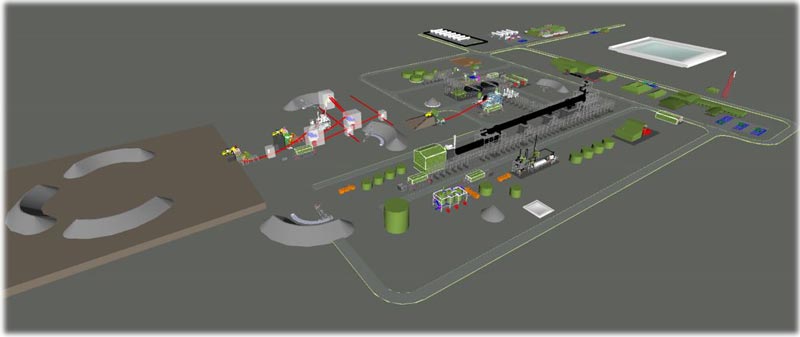Study shows Technology Metals’ Gabanintha vanadium project is worth $1.3bn

Pic: Schroptschop / E+ via Getty Images
Special report: A study of Technology Metals Australia’s wholly owned Gabanintha vanadium project has placed a pre-tax net present value (NPV) of $1.3 billion on the project – significantly higher than the company’s current market cap of just $25 million.
Technology Metals is now one of only a few ASX-listed companies to have completed a full pre-feasibility study (PFS) on an Australian vanadium project, placing it ahead of the majority of its peers.
“This is an outstanding result for the technically robust, extremely high-quality Gabanintha project in a vanadium market environment that is desperate for injection of new production,” managing director Ian Prentice said.
The PFS estimates that the 13,000-tonne-per-annum Gabanintha operation will have a pre-tax internal rate of return (IRR) of 55 per cent with a payback on capital of just 3.4 years from first drawdown.
NPV and IRR are metrics used to assess the profitability of a project. The higher the NPV and IRR, the more profitable a project will be.
The mine will have an initial 13-year life and is expected to generate $3.1 billion of total earnings before interest tax, depreciation and amortisation.
The total cost to build the operation is forecast to be around $380 million – much less than the $625 million Neometals (ASX:NMT) indicated in 2015 it would need to build its nearby Barrambie titanium and vanadium project, which is slated to produce 2,000 tonnes per annum of vanadium and 98,000 tonnes per annum of titanium.
TNG’s (ASX:TNG) Mount Peake project and King River Copper’s (ASX:KRC) Speewah project both also require a much bigger capital outlay than the Gabanintha project.
The estimated operating cost, meanwhile, compares favourably to Technology Metals’ global peers at just $US4.27 per pound of vanadium.
The grade of the Gabanintha project is also higher than the projects being developed by TNG, Neometals and King River.
Technology Metals has a reserve with a grade of 0.96 per cent vanadium. By comparison, TNG has a reserve with a grade of 0.42 per cent, Neometals’ reserve sits at a grade of 0.6 per cent and King River has a resource grade of 0.3 per cent.
There is also significant opportunity for the company to enhance the financial returns of the Gabanintha project by upgrading inferred resources, which will increase the mine life, and optimising an updated mining schedule.
Production is slated to begin in 2021.

Top quality product
Technology Metals Australia has already proven it can produce a high purity vanadium pentoxide product of over 99 per cent using low-cost conventional processing methods.
Benchmark vanadium pentoxide pricing is based on a 98 per cent purity product. The high purity of Technology Metals’ product means it could potentially receive premium pricing.
The weighted average vanadium pentoxide price used in the PFS is a conservative $US13 per pound.
But market prices are currently higher than that, with European prices ranging between $US15.50 and $US16.15 per pound and Chinese prices in the range of $US14.60 to $US15.60 per pound, reflecting the structural change currently underway in the vanadium industry.
Commodity price is a key sensitivity for the PFS financial projections and the higher the vanadium price the better the returns will be for Technology Metals.
Technology Metals is also assessing the potential to extract other valuable commodities from the Gabanintha deposit, including a base metal concentrate – such as cobalt-nickel-copper, a titanium dioxide product and a high-grade iron ore product.
Straight into definitive feasibility
The pre-feasibility study results have given Technology Metals the confidence to advance the Gabanintha project directly to the definitive feasibility study (DFS) stage.
Mr Prentice said “considerable upside” is expected from the work to be completed during the DFS.
Work will include drilling to upgrade and expand the resource, progression of potential off-take talks with vanadium end users and ongoing metallurgical test work assessing the potential to recover base metals, titanium dioxide and iron ore.
The sky is the limit
Technology Metals plans to produce more vanadium than Canada’s Largo Resources, which already has an operational mine in Brazil.
TSX-listed Largo has a market cap of $924.9 million – more than 35 times the market valuation of Technology Metals.
Largo currently produces 10,000 tonnes each year from its Maracás Menchen mine, but has announced an upgrade to attain a production rate of 12,000 tonnes per annum.
Even at the expanded capacity of 12,000 tonnes per annum, Largo will still be producing less than Technology Metals’ target production rate based on the PFS.
Technology Metals’ initial reserve estimate of 16.7 million tonnes at 0.96 percent also compares very favourably to Largo, which last reported a reserve of 19 million tonnes at 1.15 percent.
And Technology Metals will be producing at a low cost that is comparable to Largo, which says it is one of the lowest cost producers of vanadium.
Largo produced vanadium at about $US4.11 per pound in the first quarter of this year, and has provided average cost guidance of $US4.15 per pound over the course of 2018.
Technology Metals estimates its cost of production will be about $US4.27 per pound.
This special report is brought to you by Technology Metals Australia.
This advice has been prepared without taking into account your objectives, financial situation or needs. You should, therefore, consider the appropriateness of the advice, in light of your own objectives, financial situation or needs, before acting on the advice.
If this advice relates to the acquisition, or possible acquisition, of a particular financial product, the recipient should obtain a disclosure document, a Product Disclosure Statement or an offer document (PDS) relating to the product and consider the PDS before making any decision about whether to acquire the product.
UNLOCK INSIGHTS
Discover the untold stories of emerging ASX stocks.
Daily news and expert analysis, it's free to subscribe.
By proceeding, you confirm you understand that we handle personal information in accordance with our Privacy Policy.








